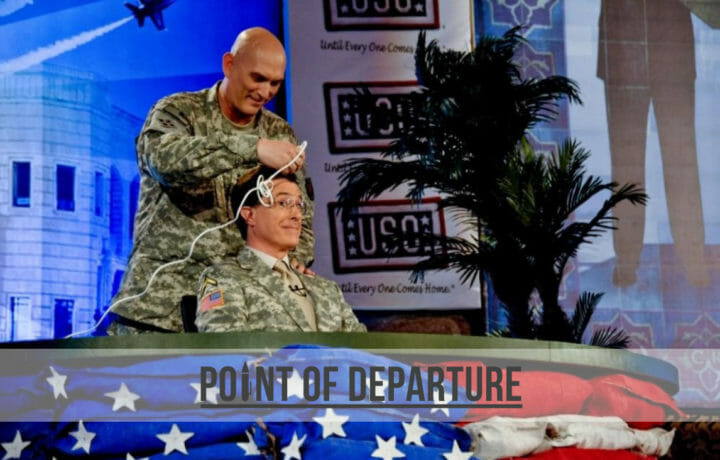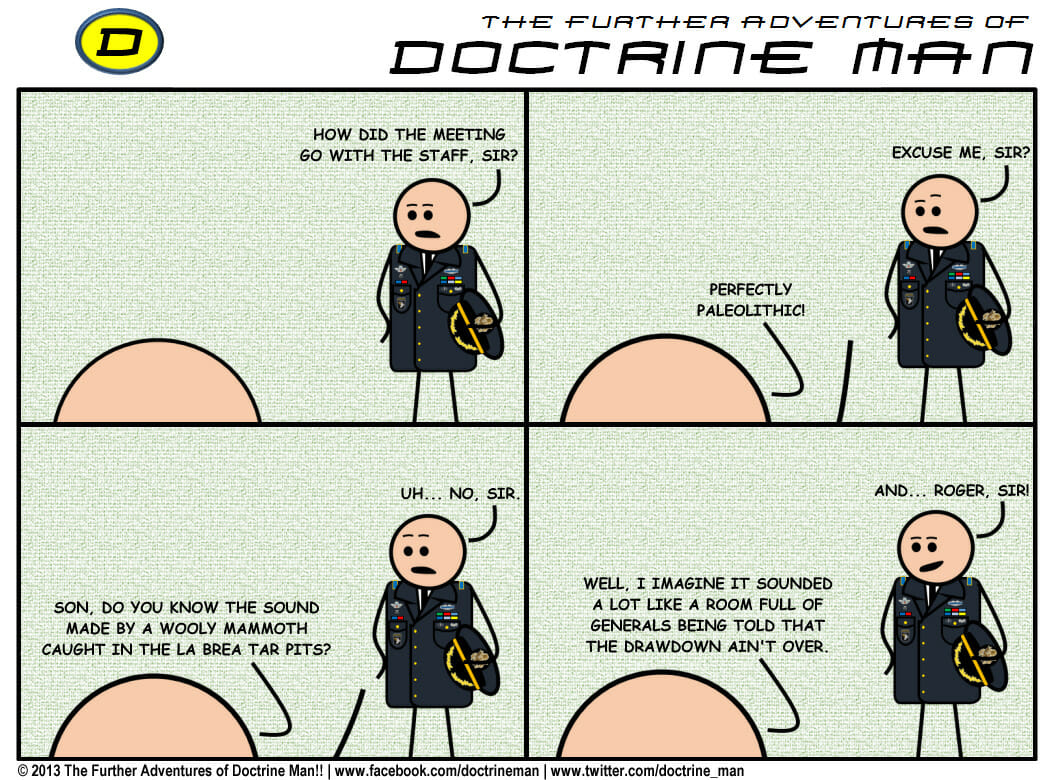One of the best kept secrets of being a mediocre cartoonist is the true identities of the characters that live their lives within the panels of a comic. Each character owes its existence to an actual, living human being, who through some action – or inaction – of their own served as in inspiration in some way. Over the years, my green government-issue notebook collected those moments of inspiration, and the characters would eventually appear on the digital pages of Doctrine Man. It was not unusual for people to see themselves in the characters. Sometimes, that was a good thing; other times, maybe less so.
THE CHIEF ARRIVES
One such moment occurred in the late fall of 2013, as the Army was facing down a looming manpower crisis that would eventually lead to force reductions. Sitting at the head of the horseshoe-shaped conference room table in the Combined Arms Center headquarters at Fort Leavenworth, General Ray Odierno, the Army Chief of Staff, was animatedly discussing the challenges ahead. He was speaking with his hands, gesturing in a way that immediately reminded me of the actor who portrayed former New York Yankees owner George Steinbrenner on Seinfeld. I flipped my green notebook to the back, where a single red tab marked the one place where I actually kept notes. I scribbled out some quick thoughts and closed the notebook.
Shortly before the Thanksgiving holiday, The Chief made his first appearance. As with Larry David’s portrayal of Steinbrenner, readers would only ever see the back of The Chief’s head, and his arms would share the same animated flailing to emphasize his comments. I took some liberties with those comments… but not much. The Chief became a regular character from that point, and I assumed the odds were low that General Odierno would ever see the comics or draw the connection. In a comic where none of the characters had hair, who would notice one more?
HAIL TO THE CHIEF
When I first heard news of his passing last week at the age of 67, it stung a little. He was too young to go. He still had so much to give, so many things left to do. He had always been a larger-than-life character – literally, in fact – and someone who seemed beyond the earthly limits of us mere mortals. But cancer isn’t one of those things that plays by our rules. It sucks, as we all know.
His 39 years in uniform were more than noteworthy. At 6-foot-5, his presence was difficult to miss. A graduate of the United States Military Academy, he played a pivotal role in revitalizing the football program after years of making the other academies feel good about themselves. Although he commissioned in the Field Artillery, he was much more than a cannoneer. When he appeared on The Colbert Report in 2009, he showed a side of his personality that engendered so much loyalty – and comparisons to Shrek – over the years. A division, corps, and theater-level commander in Iraq, his consistent presence there seemed to be just another part of the landscape. In total, he spent more than 55 months in country; he left for the last time in 2010.
As the 38th Chief of Staff of the U.S. Army, he faced some of his most difficult battles: budget woes, a government shutdown, and sequestration. At a Senate Armed Services Committee hearing in 2013, he remarked, “I began my career in a hollow Army. I am determined not to end my career in a hollow Army.” That tenacity, that determination, is what most of us remember about The Chief. He fought tirelessly for the soldiers under his watch, of whom he held the highest regard: “We owe that to the young men and women who are willing to raise their right hand and defend this country.”
A FINAL FAREWELL
Several months after The Chief made his first appearance as a character, I found myself in yet another conference room with the real Chief. The topic of discussion that day was Army doctrine, a subject that always seems to bring out the passion in senior leaders. The pages of my green notebook capture a lot of back-and-forth about Doctrine 2015, an initiative that featured a “highly coveted” boxed set of short manuals that would become known as the box o’ doctrine and eventually draw comparisons to an infamous Saturday Night Live skit.
As the initial bustle and banter of the meeting simmered to a low mutter, the Chief set the stage for the discussion, concluding with a brief warning: “… and none of this had better show up in a cartoon.” The Chief gave me a subtle smirk and a nod, and the meeting continued. So, yeah. He recognized himself in those cartoons, after all. He made the connection. Go figure.
Farewell, Chief. We’ll see you again on the high ground.



